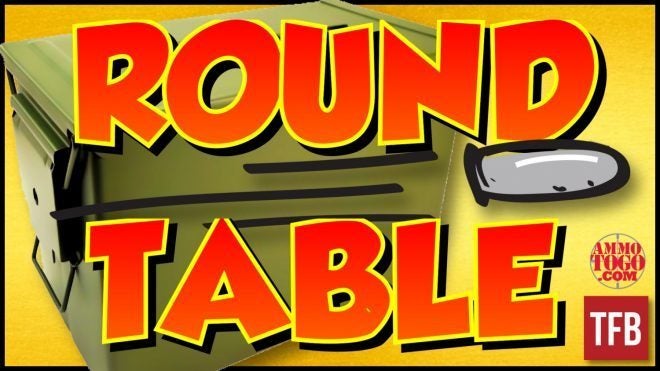Welcome back to another edition of the TFB Round Table sponsored by Ammunition To Go! For those who are first joining us, this is a multi-part series where TFB discusses the characteristics of great ammunition for specific applications. This could vary from big game hunting, plinking, precision rifle matches, small game hunting, or even pistol competitions. Chances are there is someone here at TFB who can offer you advice on buying the right round for your task at hand. This week I am back on TFB Round Table to discuss and recommend a cartridge that is pretty obscure in the firearms industry. The cartridge in question is that of 9×23 Steyr otherwise known as 9mm Steyr. Do you have an old Austrian service pistol chambered in this oddly comfortable cartridge? Are you finding yourself pondering why it’s not a common cartridge? Stay tuned! Let’s dive right into the lovable 9×23 and some ammunition options and information to bring your old gat back to the range!
TFB ROUND TABLE: THE 9mm Steyr ORIGIN STORY
It is difficult to talk about 9mm Steyr without first discussing the fantastically unique looking Steyr M12. This 20th-century military pistol has many names. The most common ones you will see are the Steyr 1912 or Steyr Hahn, but you may also find it referred to as the Steyr “Hammer” or by some of the early first developed ones, the Steyr 1911. Speaking of 1911 in the sense of the one most of the world knows and loves, it wouldn’t surprise me if you yourself ever hear someone describing the Steyr 1912 as “if Picasso designed a Colt 1911”. It is truly an interesting chunk of art. Despite its looks and even its name it actually draws most of its inspiration from three military-style pistols that are not our beloved Colt 1911. The ones I speak of are the Roth-Steyr 1907, the Colt M1902, and the Mannlicher M1905. Put all of those together and give it an admirable soft recoiling 9×23 cartridge and you get this:

Photo Credit: Wikimedia Commons
What a beautiful beast, huh? If you are curious to see more photos or even some other variants that never really saw any use, make sure to check out this POTD from 2016. Size-wise the Steyr m12 was very comparable to that of the previously mentioned Colt 1911. Other than the caliber, the biggest differences in design would be the Steyr is a short recoil operation in which the barrel travels with the breech face part of the way back and twists in grooves 20° and it also has an internal and non-removable magazine that is filled via an eight-round stripper clip of 9×23 Steyr.
As world war one erupted, the Steyr 1912 was adopted by the Austro-Hungarian military in 1914 even though it had previously rejected the earlier 1911 variant in favor of the Roth-Steyr 1907. Due to ŒWG’s (Steyr Mannlicher) production ability and the lack of other options since import and export were impossible, the Steyr 1912 and its 9×23 rimless straight-walled case holding a 115-grain FMJ bullet was adopted.

9mm Largo, 9mm Luger, 9x23mm Winchester, 9x23mm Steyr. Photo Credit: Wikimedia Commons
Later in its life, this cartridge would be chambered in some MP34 submachine guns and even a full auto variant of the Steyr 1912 sporting a stock and extended magazine. Sadly, this caliber fell out of popularity and remains to only belong to one true firearm and that would be the much more obtainable Steyr 1912. The rise of the 9×19 cartridge was much more prevalent, even to the point where during World War 2 the German government issued Steyr 1912s rechambered in 9×19 parabellum to police forces in Germany and Austria. The 9mm converted pistols will have an “08” stamped on the left side of the slide. These rechambered ones can still be found and fired but are known to be finicky and tend to malfunction.
For a little more information on the 9mm Steyr round here is Ammunition to Go to save the day:
9mm Steyr ammunition is a very robust round chambered for one of the most robust and well designed pistols in the 20th century. The 9mm Steyr was produced in1911 to replace the 8mm Steyr. The 9×23 mm Steyr was adopted by all of the branches of the Austria-Hungary military during the First World War. At the time, the Austrian-Hungarian military was one of the most modern and well equipped armies in the world. In the post War World the round found service in Romania and Chile.
9mm Steyr ammo was also loaded in 1911 clones for countries which restricted the use of NATO or military rounds, like Mexico. The cartridge is quite robust and was one of the earliest 9mm rounds to use the idea of smaller lighter rounds, with extremely high velocities. This produced a smaller, easier to manufacture round, which was more controllable than larger loads. These high velocity rounds were more apt to penetrate barriers than larger, slower rounds as well.
TFB ROUND TABLE: WHAT’RE WE LOOKING FOR HERE?
If you happen to own a work of Austrian art chambered in this obscure cartridge, there are a few things to consider. You have an old Steyr 1912 in working condition, or even a transferable MP34, you lucky duck. Regardless, it is important to know your intent and even better yet know what you are looking for in terms of 9×23 Steyr.
- Surplus Ammo?
- Bullet Grain Weight
- Ammunition Interchangeability
So starting with surplus ammunition, it can still be found today and it will usually be sporting a few giveaways. The giveaways in question would be a silver looking FMJ bullet and can be in the plain blue or gray labeled boxes much like the one pictured with the M12 above. The surplus ammo is known to be fairly corrosive and should be used and maintained with that in mind. Take care of your piece of history! Bullet grain weights are consistent across the board at 115, so whatever ammo option you happen upon it will feel super similar to what it would have felt recoiling in an Austrian soldier’s hands.
Ammunition interchangeability is slim to none. Although 9×23 Largo and Winchester are similar in dimensions they are not interchangeable in regards to the Steyr 1912. Some claim that it is perfectly alright, but it should be noted that later production Largo was loaded hotter for consistent cycling in submachine guns and Largo rims are larger than Steyr rims, so forcing your gun to be potentially out of headspace is sketchy. Do not put factory/surplus 9mm Largo in your Steyr! It is not worth harming yourself or your firearm.
As always, thank you for reading TFB! Be safe out there, have fun while shooting, and we will see you next time for TFB’s Round Table brought to you by Ammunition to Go! Also, let us know what you think in the Comments below! We always appreciate your feedback.
TFB’S ROUND TABLE IS BROUGHT TO YOU BY AMMOTOGO.COM
PCI 9mm Steyr 115 Grain FMJ
PCI 9mm Steyr 115gr. FMJ
https://www.ammunitiontogo.com/product_info.php/pName/50rds-9mm-steyr-pci-fmj

9mm Steyr ammunition is a very robust round chambered for one of the most robust and well designed pistols in the 20th century. The 9mm Steyr was produced in1911 to replace the 8mm Steyr. The 9×23 mm Steyr was adopted by all of the branches of the Austria-Hungary military during the First World War. At the time, the Austrian-Hungarian military was one of the most modern and well equipped armies in the world. In the post War World the round found service in Romania and Chile.
This round comes loaded with a 115 grain bullet and is produced by Precision Cartridge Inc.
 Your Privacy Choices
Your Privacy Choices
